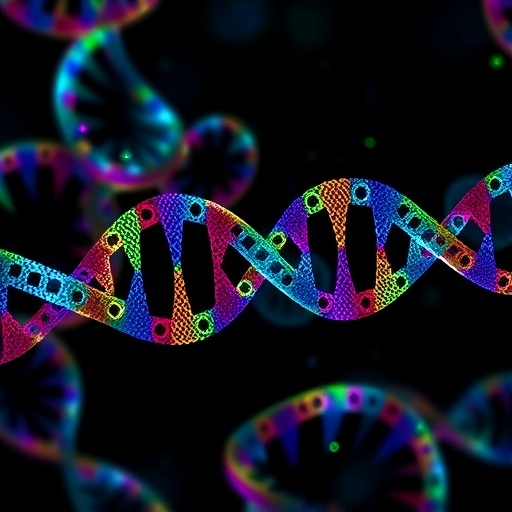In a groundbreaking study poised to redefine our understanding of genetic vulnerabilities in cancer and DNA repair mechanisms, researchers have executed a comprehensive analysis of synthetic lethality within the DNA damage response (DDR). This monumental work employs cutting-edge CRISPR interference (CRISPRi) screening techniques in conjunction with sophisticated dual-guide RNA libraries, unraveling intricate genetic interactions that govern cellular responses to DNA damage. The findings pave new avenues for targeted therapies, emphasizing the therapeutic potential of exploiting synthetic lethal gene pairs in oncology.
At the heart of the investigation lies the strategic use of human cell lines—hTERT RPE-1 TP53 knockout cells, HeLa S3 dCas9–ZIM3, and K562 dCas9–KRAB cells—cultured under precisely controlled hypoxic (3% oxygen) conditions. This fine-tuned environment mimics physiological conditions more accurately than traditional normoxia, offering a robust platform for dissecting the nuanced interplay of DDR pathways. The employment of CRISPRi, as opposed to knockout-based methods, circumvents confounding lethal effects of complete gene ablation while enabling graded repression, thereby capturing subtler genetic effects.
To craft their expansive dual-guide RNA library targeting 548 genes implicated in DNA repair, the team integrated computational predictions with empirical data from over 50 prior CRISPRi screens. This hybrid strategy prioritized sgRNAs based on growth phenotypes in multiple cancer cell types, including neuroblastoma lines, to ensure robust targeting of genes with essential and context-dependent roles. Notably, the library design incorporated mismatched sgRNA variants with calibrated partial activity, augmenting the sensitivity and specificity of interaction discovery.
The experimental workflow represents a tour de force in genetic screening technology. Cells were transduced at low multiplicity of infection with the dual-guide lentiviral library, maintaining high coverage to secure statistical power. After stringent antibiotic selection, cells underwent approximately ten population doublings, allowing genetic perturbation effects to manifest. Through deep sequencing of integrated sgRNA cassettes and meticulous bioinformatics pipelines including GEMINI analysis, the researchers quantified the log-fold changes in sgRNA abundance, extracting genetic interaction scores indicative of synthetic lethality or buffering relationships.
Emergent from this massive dataset is a high-resolution genetic interaction network outlining functional clusters of DNA repair genes. Intriguingly, clusters of genes encoding proteins involved in replication fork stability, homologous recombination, and translesion synthesis yielded strong synthetic lethal pairs, underscoring cooperative pathways essential for maintaining genomic integrity. Cross-referencing with STRING protein interaction databases revealed these clusters corresponded to physically interacting molecular machinery, validating the biological significance of the interactions detected.
Complementary assays employing dual-color flow cytometry enabled dynamic monitoring of competitive growth between cells harboring different sgRNA combinations, substantiating the synthetic lethal relationships predicted by the screen. Clonogenic survival and competitive growth experiments further confirmed the synergistic sensitivities to selective gene knockdowns, particularly when combined with DNA damaging agents. Such functional validations highlight the therapeutic promise of combining targeted gene repression with conventional chemotherapy or emerging DDR inhibitors.
At the molecular level, the study delved into the roles of FANCM and SMARCAL1—key DNA motor proteins involved in replication stress responses. These genes were subject to CRISPR-mediated knockout and further characterized using biochemical assays with purified proteins. In vitro unfolding assays demonstrated their ability to resolve complex DNA secondary structures, including cruciform DNA intermediates enriched at TA-rich repeats, suggesting a direct mechanistic role in protecting stalled replication forks from collapse.
ChIP–seq analysis illuminated genome-wide binding profiles of FANCM, SMARCAL1, and MRE11, revealing their preferential localization to genomic loci enriched in AT repeats and potential cruciform structures. These data further support a model where coordinated action of these proteins safeguards replication fork progression through challenging genomic landscapes. The synergistic relationship between FANCM and SMARCAL1, particularly under replication stress, was reinforced by epistasis analysis of double gene knockouts, which exhibited exacerbated DNA damage phenotypes.
Through incorporation of next-generation proteomics, the authors captured dynamic ubiquitin remnant modifications (diGly proteomics) across various perturbations. This approach spotlighted post-translational regulation pathways activated upon DNA damage, extending insights into the molecular crosstalk underpinning synthetic lethality. Phosphorylation and ubiquitination signatures unveiled potential regulatory nodes within the DNA repair network, offering targets for pharmacologic intervention.
Meticulous live-cell imaging using FUCCI reporters and H2B–GFP fusion proteins detailed cell cycle progression and mitotic abnormalities following gene knockdowns and small molecule treatments. Prolonged mitotic arrest and catastrophic chromosomal fragmentation were observed in synthetic lethal contexts, linking genetic perturbations to cell fate decisions and genome instability phenotypes. This dynamic visualization complements static molecular assays, providing a temporal dimension to the DDR landscape.
This comprehensive interrogation not only identifies novel lethal gene pairs with high translational relevance but also exemplifies the power of integrating sophisticated genetic tools with multi-omic profiling and live-cell analyses. The study lays a foundation for rational development of combinatorial therapies exploiting synthetic lethality in cancer, potentially overcoming resistance mechanisms and enhancing precision medicine strategies.
In conclusion, this expansive investigation charts an unprecedented map of synthetic lethal interactions within the DNA damage response, bridging molecular mechanisms with functional dependencies. Its integrative experimental design and extensive validation provide a roadmap for future efforts aiming to translate genetic vulnerabilities into therapeutic opportunities. As DNA repair remains a cornerstone of genome stability and cancer biology, such systematic exploration promises profound impacts on understanding and combating malignancies.
Subject of Research:
Synthetic lethality and genetic interactions in the DNA damage response.
Article Title:
Comprehensive interrogation of synthetic lethality in the DNA damage response.
Article References:
Fielden, J., Siegner, S.M., Gallagher, D.N. et al. Comprehensive interrogation of synthetic lethality in the DNA damage response. Nature (2025). https://doi.org/10.1038/s41586-025-08815-4
Image Credits:
AI Generated




